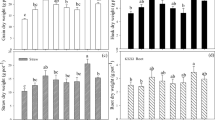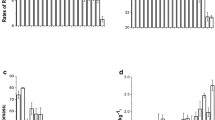Abstract
A pot experiment was carried out to investigate the effects of water management and mycorrhizal inoculation on arsenic (As) uptake by two rice varieties, the As-resistant BRRI dhan 47 (B47) and As-sensitive BRRI dhan 29 (B29). Grain As concentration of B47 plants was significantly lower than that of B29, and grain As concentration of B47 was higher under flooding conditions than that under aerobic conditions. In general, mycorrhizal inoculation (Rhizophagus irregularis) had no significant effect on grain As concentrations, but decreased the proportion of inorganic arsenic (iAs) in grains of B47. The proportion of dimethylarsinic acid (DMA) in the total grain As was dramatically higher under flooding conditions. Results demonstrate that rice variety selection and appropriate water management along with mycorrhizal inoculation could be practical countermeasures to As accumulation and toxicity in rice grains, thus reducing health risks of As exposure in rice diets.





Similar content being viewed by others
Abbreviations
- AMF:
-
Arbuscular mycorrhizal fungi
- As:
-
Arsenic
- As(III):
-
Arsenite
- As(V):
-
Arsenate
- B29:
-
BRRI dhan 29
- B47:
-
BRRI dhan 47
- DMA:
-
Dimethylarsinic acid
- HPLC-ICP-MS:
-
High performance liquid chromatography-inductively coupled plasma-massspectrometry
- iAs:
-
Inorganic arsenic
- ICP-OES:
-
Inductively coupled plasma-optical emission spectrometer
- ICP-MS:
-
Inductively coupled plasma-mass spectroscopy
- MMA:
-
Monomethylarsonic acid
- R. irregularis :
-
Rhizophagus irregularis
- TFA:
-
Trifluoroacetic acid
References
Abedin MJ, Feldmann J, Meharg AA (2002) Uptake kinetics of arsenic species in rice plants. Plant Physiol 128:1120–8. doi:10.1104/pp. 010733
Arao T, Kawasaki A, Baba K, Mori S, Matsumoto S (2009) Effects of water management on cadmium and arsenic accumulation and dimethylarsinic acid concentrations in Japanese rice. Environ Sci Technol 43:9361–7. doi:10.1021/es9022738
Burleigh SH, Cavagnaro T, Jakobsen I (2002) Functional diversity of arbuscular mycorrhizas extends to the expression of plant genes involved in P nutrition. J Exp Bot 53:1593–601. doi:10.1093/jxb/erf013
Caporale AG, Sarkar D, Datta R, Punamiya P, Violante A (2014) Effect of arbuscular mycorrhizal fungi (Glomus spp.) on growth and arsenic uptake of vetiver grass (Chrysopogon zizanioides L.) from contaminated soil and water systems. J Soil Sci Plant Nut 14:955–72
Carey AM, Norton GJ, Deacon C et al (2011) Phloem transport of arsenic species from flag leaf to grain during grain filling. New Phytol 192:87–98. doi:10.1111/j.1469-8137.2011.03789.x
Chan WF, Li WC, Wong MH (2015) Uptake kinetics of arsenic in upland rice cultivar Zhonghan 221 inoculated with arbuscular mycorrhizal fungi. Int J Phytorem 17:1073–80. doi:10.1080/15226514.2015.1021952
Chen B, Xiao X, Zhu Y-G, Smith FA, Xie ZM, Smith SE (2007) The arbuscular mycorrhizal fungus Glomus mosseae gives contradictory effects on phosphorus and arsenic acquisition by Medicago sativa Linn. Sci Total Environ 379:226–34. doi:10.1016/j.scitotenv.2006.07.038
Christophersen HM, Smith FA, Smith SE (2012) Unraveling the influence of arbuscular mycorrhizal colonization on arsenic tolerance in Medicago: Glomus mosseae is more effective than G. intraradices, associated with lower expression of root epidermal Pi transporter genes. Front Physiol 3:91. doi: 10.3389/fphys.2012.00091
Cullen WR, Reimer KJ (1989) Arsenic speciation in the environment. Chem Rev 89:713–64. doi:10.1021/cr00094a002
Dong Y, Zhu YG, Smith FA, Wang YS, Chen BD (2008) Arbuscular mycorrhiza enhanced arsenic resistance of both white clover (Trifolium repens L.) and ryegrass (Lolium perenne L.) plants in an arsenic-contaminated soil. Environ Pollut 15:174–81. doi:10.1016/j.envpol.2007.10.023
Fitz WJ, Wenzel WW (2002) Arsenic transformations in the soil-rhizosphere-plant system: fundamentals and potential application to phytoremediation. J Biotechnol 99:259–78. doi:10.1016/s0168-1656(02)00218-3
Giovannetti M, Mosse B (1980) Evaluation of techniques for measuring vesicular arbuscular mycorrhizal infection in roots. New Phytol 84:489–500. doi:10.1111/j.1469-8137.1980.tb04556.x
Gonzalez-Chavez C, Harris PJ, Dodd J, Meharg AA (2002) Arbuscular mycorrhizal fungi confer enhanced arsenate resistance on Holcus lanatus. New Phytol 15:163–71. doi:10.1046/j.1469-8137.2002.00430.x
He XH, Lilleskov E (2014) Arsenic uptake and phytoremediation potential by arbuscular mycorrhizal fungi. In: Zakaria MS, Lynette KA, Ajit V (eds) Mycorrhizal fungi: use in sustainable agriculture and land restoration, 1st edn. Springer-Verlag, Berlin Heidelberg, pp 259–275
Jia Y, Huang H, Sun G-X, Zhao F-J, Zhu Y-G (2012) Pathways and relative contributions to arsenic volatilization from rice plants and paddy soil. Environ Sci Technol 46:8090–6. doi:10.1021/es300499a
Li RY, Ago Y, Liu WJ, Mitani N, Feldmann J, McGrath SP, Ma JF, Zhao FJ (2009a) The rice aquaporin Lsi1 mediates uptake of methylated arsenic species. Plant Physiol 150:2071–80. doi:10.1104/pp. 109.140350
Li RY, Stroud JL, Ma JF, McGrath SP, Zhao FJ (2009b) Mitigation of arsenic accumulation in rice with water management and silicon fertilization. Environ Sci Technol 43:3778–83. doi:10.1021/es803643v
Li H, Ye ZH, Chan WF, Chen XW, Wu FY, Wu SC, Wong MH (2011) Can arbuscular mycorrhizal fungi improve grain yield, As uptake and tolerance of rice grown under aerobic conditions? Environ Pollut 159:2537–45. doi:10.1016/j.envpol.2011.06.017
Li H, Man YB, Ye ZH, Wu C, Wu SC, Wong MH (2013) Do arbuscular mycorrhizal fungi affect arsenic accumulation and speciation in rice with different radial oxygen loss? J Hazard Mater 262:1098–104. doi:10.1016/j.jhazmat.2012.05.044
Liao XY, Chen TB, Xie H, Liu YR (2005) Soil As contamination and its risk assessment in areas near the industrial districts of Chenzhou City, Southern China. Environ Int 31:791–8. doi:10.1016/j.envint.2005.05.030
Liu Y, Zhu YG, Chen BD, Christie P, Li XL (2005) Yield and arsenate uptake of arbuscular mycorrhizal tomato colonized by Glomus mosseae BEG167 in As spiked soil under glasshouse conditions. Environ Int 31:867–73. doi:10.1016/j.envint.2005.05.041
Lomax C, Liu WJ, Wu L, Xue K, Xiong J, Zhou J, McGrath SP, Meharg AA, Miller AJ, Zhao FJ (2012) Methylated arsenic species in plants originate from soil microorganisms. New Phytol 193:665–72. doi:10.1111/j.1469-8137.2011.03956.x
Meharg AA (2004) Arsenic in rice—understanding a new disaster for South-East Asia. Trends Plant Sci 9:415–7. doi:10.1016/j.tplants.2004.07.002
Meharg AA, Williams PN, Adomako E et al (2009) Geographical variation in total and inorganic arsenic content of polished (white) rice. Environ Sci Technol 43:1612–7. doi:10.1021/es802612a
Norton GJ, Islam MR, Deacon CM, Zhao FJ, Stroud JL, McGrath SP, Islam S, Jahiruddin M, Feldmann J, Price AH, Meharg AA (2009) Identification of low inorganic and total grain arsenic rice cultivars from Bangladesh. Environ Sci Technol 43:6070–5. doi:10.1021/es901121j
Olsen SR, Cole CV, Watanabe FS, Dean LA (1954) Estimation of available phosphorus in soils by extraction with sodium bicarbonate. USDA Circular: No. 939:1–19. http://krishikosh.egranth.ac.in/handle/1/2041713
Orlowska E, Godzik B, Turnau K (2012) Effect of different arbuscular mycorrhizal fungal isolates on growth and arsenic accumulation in Plantago lanceolata L. Environ Pollut 168:121–30. doi:10.1016/j.envpol.2012.04.026
Pearson JN, Jakobsen I (1993) The relative contribution of hyphae and roots to phosphorous uptake by arbuscular mycorrhiza plants, measured by dual labeling with P-32 and P-33. New Phytol 124:489–94. doi:10.1111/j.1469-8137.1993.tb03840.x
Phillips JM, Hayman DS (1970) Improved procedures for clearing roots and staining parasitic and vesicular-arbuscular mycorrhizal fungi for rapid assessment of infection. Trans Brit Mycol Soc 55:158–61
Rahman MM, Rahman MA, Maki T, Hasegawa H (2012) Phytotoxicity of arsenate and salinity on early seedling growth of rice (Oryza sativa L.): a threat to sustainable rice cultivation in South and South-East Asia. B Environ Contam Tox 88:695–702. doi:10.1007/s00128-012-0580-4
Schüßler A,Walker C (2010) The glomeromycota: a species list with new families and new genera 1–58. Libraries at The Royal Botanic Garden Edinburgh, The Royal Botanic Garden Kew, Botanische Staatssammlung Munich, and Oregon State University. Available at: www.amf-phylogeny.com
Sinha B, Bhattacharyya K (2015) Arsenic toxicity in rice with special reference to speciation in Indian grain and its implication on human health. J Sci Food Agric 95:1435–44. doi:10.1002/jsfa.6839
Smith SE, Read DJ (2008) Mycorrhizal symbiosis. Academic, London, UK
Smith SE, Smith FA, Jakobsen I (2004) Functional diversity in arbuscular mycorrhizal (AM) symbioses: the contribution of the mycorrhizal P uptake pathway is not correlated with mycorrhizal responses in growth or total P uptake. New Phytol 162:511–24. doi:10.1111/j.1469-8137.2004.01039.x
Smith SE, Christophersen HM, Pope S, Smith FA (2010) Arsenic uptake and toxicity in plants: integrating mycorrhizal influences. Plant Soil 327:1–21. doi:10.1007/s11104-009-0089-8
Somenahally AC, Hollister EB, Loeppert RH, Yan WG, Gentry TJ (2011a) Microbial communities in rice rhizosphere altered by intermittent and continuous flooding in fields with long-term arsenic application. Soil Biol Biochem 43:1220–8. doi:10.1016/j.soilbio.2011.02.011
Somenahally AC, Hollister EB, Yan WG, Gentry TJ, Loeppert RH (2011b) Water management impacts on arsenic speciation and iron-reducing bacteria in contrasting rice-rhizosphere compartments. Environ Sci Technol 45:8328–35. doi:10.1021/es2012403
Spagnoletti F, Lavado RS (2015) The arbuscular mycorrhiza Rhizophagus intraradices reduces the negative effects of arsenic on soybean plants. Agronomy 5:188–99. doi:10.3390/agronomy5020188
Stone R (2008) Food safety—arsenic and paddy rice: a neglected cancer risk? Science 321:184–5. doi:10.1126/science.321.5886.184
Syu CH, Huang CC, Jiang PY, Lee CH, Lee DY (2015) Arsenic accumulation and speciation in rice grains influenced by arsenic phytotoxicity and rice genotypes grown in arsenic-elevated paddy soils. J Hazard Mater 286:179–86. doi:10.1016/j.jhazmat.2014.12.052
Talukder ASMHM, Meisner CA, Sarkar MAR, Islam MS, Sayre KD, Duxbury JM, Lauren JG (2012) Effect of water management, arsenic and phosphorus levels on rice in a high-arsenic soil-water system: II. Arsenic uptake. Ecotox Environ Safe 80:145–51. doi:10.1016/j.ecoenv.2012.02.020
Ultra VU, Tanaka S, Sakurai K, Iwasaki K (2007) Effects of arbuscular mycorrhiza and phosphorus application on arsenic toxicity in sunflower (Helianthus annuus L.) and on the transformation of arsenic in the rhizosphere. Plant Soil 29:29–41. doi:10.1007/s11104-006-9087-2
Williams PN, Price AH, Raab A, Hossain SA, Feldmann J, Meharg AA (2005) Variation in arsenic speciation and concentration in paddy rice related to dietary exposure. Environ Sci Technol 39:5531–40. doi:10.1021/es0502324
Williams PN, Villada A, Deacon C, Raab A, Figuerola J, Green AJ, Feldmann J, Meharg AA (2007) Greatly enhanced arsenic shoot assimilation in rice leads to elevated grain levels compared to wheat and barley. Environ Sci Technol 41:6854–9. doi:10.1021/es070627i
Williams PN, Lei M, Sun G, Huang Q, Lu Y, Deacon C, Meharg AA, Zhu YG (2009) Occurrence and partitioning of cadmium, arsenic and lead in mine impacted paddy rice: Hunan, China. Environ Sci Technol 43:637–42. doi:10.1021/es802412r
Wu C, Ye Z, Shu W, Zhu Y, Wong M (2011) Arsenic accumulation and speciation in rice are affected by root aeration and variation of genotypes. J Exp Bot 62:2889–98. doi:10.1093/jxb/erq462
Xia YS, Chen BD, Christie P, Smith FA, Wang YS, Li XL (2007) Arsenic uptake by arbuscular mycorrhizal maize (Zea mays L.) grown in an arsenic-contaminated soil with added phosphorus. J Environ Sci (China) 1:1245–51. doi:10.1016/S1001-0742(07)60203-4
Xu XY, McGrath SP, Meharg AA, Zhao FJ (2008) Growing rice aerobically markedly decreases arsenic accumulation. Environ Sci Technol 42:5574–9. doi:10.1021/es800324u
Zavala YJ, Gerads R, Gürleyük H, Duxbury JM (2008) Arsenic in rice. II. Arsenic speciation in USA grain and implications for human health. Environ Sci Technol 42:3861–6. doi:10.1021/es702748q
Zhang X, Ren BH, Wu SL, Sun YQ, Lin G, Chen BD (2015) Arbuscular mycorrhizal symbiosis influences arsenic accumulation and speciation in Medicago truncatula L. in arsenic-contaminated soil. Chemosphere 119:224–30. doi:10.1016/j.chemosphere.2014.06.042
Zhao FJ, Zhu YG, Meharg AA (2013) Methylated arsenic species in rice: geographical variation, origin, and uptake mechanisms. Environ Sci Technol 47:3957–66. doi:10.1021/es304295n
Zheng MZ, Cai C, Hu Y, Sun GX, Williams PN, Cui HJ, Li G, Zhao FJ, Zhu YG (2011) Spatial distribution of arsenic and temporal variation of its concentration in rice. New Phytol 189:200–9. doi:10.1111/j.1469-8137.2010.03456.x
Zhu YG, Williams PN, Meharg AA (2008a) High percentage inorganic arsenic content of mining impacted and nonimpacted Chinese rice. Environ Sci Technol 42:5008–13. doi:10.1021/es8001103
Zhu YG, Williams PN, Meharg AA (2008b) Exposure to inorganic arsenic from rice: a global health issue? Environ Pollut 154:169–71. doi:10.1016/j.envpol.2008.03.015
Acknowledgments
We thank Prof. M. Tofazzal Islam from Bangabandhu Sheikh Mujibur Rahman Agricultural University for kindly supplying the seeds of BRRI dhan 47 and BRRI dhan 29 for the investigation. This study was financially supported by the National Natural Science Foundation of China (41101246, 41471219) and the International Foundation for Science, Stockholm, Sweden, through a grant to Xin Zhang (NO. C/4973-1).
Author information
Authors and Affiliations
Corresponding author
Additional information
Xin Zhang and Songlin Wu contributed equally to this work.
Rights and permissions
About this article
Cite this article
Zhang, X., Wu, S., Ren, B. et al. Water management, rice varieties and mycorrhizal inoculation influence arsenic concentration and speciation in rice grains. Mycorrhiza 26, 299–309 (2016). https://doi.org/10.1007/s00572-015-0669-9
Received:
Accepted:
Published:
Issue Date:
DOI: https://doi.org/10.1007/s00572-015-0669-9




